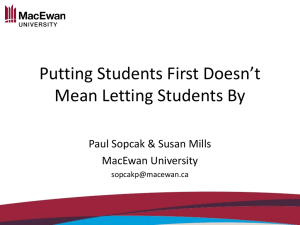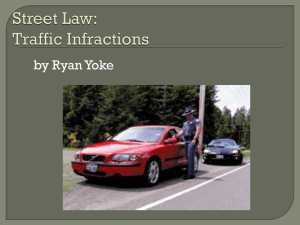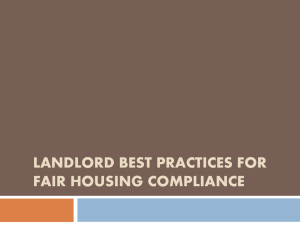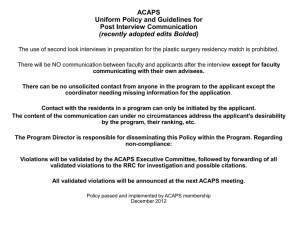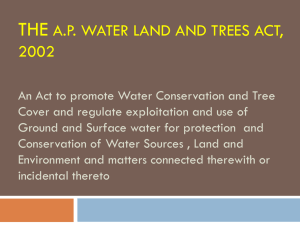Responding to Rule Violations Day 2
advertisement
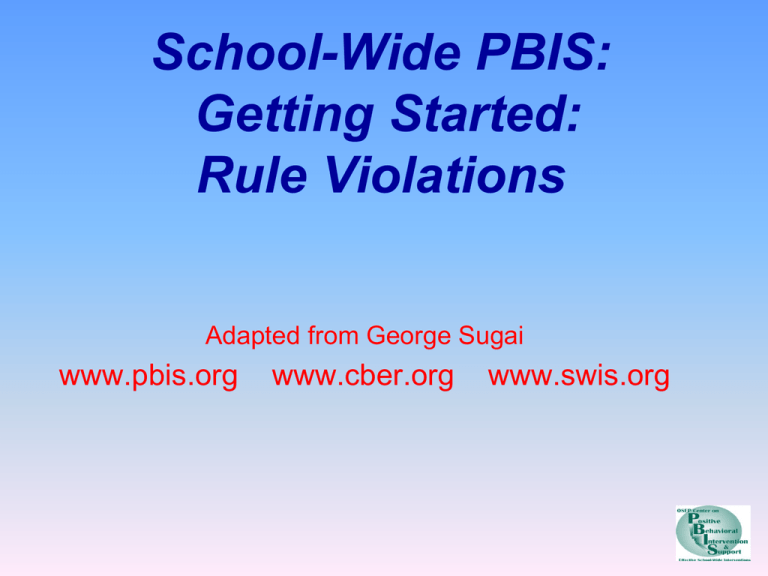
School-Wide PBIS: Getting Started: Rule Violations Adapted from George Sugai www.pbis.org www.cber.org www.swis.org Getting Started - Today • Chapter 2, Page 68 – 70 (Step 7) – Defining Rules Violations – Processing Rule Violations Class vs Office • Practices & Systems – Discouraging rule violations – Rule Violation Worksheet “141 Days!” Intermediate/senior high school with 880 students reported over 5,100 office discipline referrals in one academic year. Nearly 2/3 of students have received at least one office discipline referral. 5100 referrals = 51,000 min @10 min = 850 hrs = 141 days @ 6 hrs “Smoke Pit” 45 cigarette smoking violations have been reported in past month by security staff & neighbors. “Where ya supposed to be? During 3rd & 6th block periods, more students are in the hallways & outside the building than in class…& neighbors are complaining! MS/HS worry about… • Low academic achievement • Antisocial school culture & behavior – Insubordination, dress code, language use, etc – Low attendance, tardies, substance use – Withdrawal, depression, emotional disturbances – Dropping out, substance use, delinquency • Graduation, careers, postsecondary • Social skill deficits 2 Worrisome & Ineffective Responses to Problem Behavior • Get Tough (practices) • Train-&-Hope (systems) Worry #1: Getting Tough approach Runyon: “I hate this f____ing school, & you’re a dumbf_____.” Teacher: “That is disrespectful language. I’m sending you to the office so you’ll learn never to say those words again. When you’re ready to take responsibility for your actions & behave like an adult, you can be in my classroom!” Increasingly “aversive” reactive discipline continuum • Warning • ODR & warning • ODR & in-school suspension • ODR & out-school suspension • Expulsion hearing Get Tough Philosophy • Increase monitoring for future problem behavior • Clamp down on rule violators • Re-re-re-review rules & sanctions • Extend continuum of aversive consequences • Improve consistency of use of punishments • Establish “bottom line” Predictable reactive responses When we experience aversive situation, we select interventions that produce immediate relief by – Removing student – Removing ourselves – Modifying physical environment – Assign responsibility for change to student &/or others System’s response…Get tougher • Zero tolerance policies • Security guards & metal detectors, & surveillance cameras • Student uniforms • Expulsion • Exclusionary options (e.g., alternative programs) But….false sense of safety & security! • Fosters environments of control • Triggers & reinforces antisocial behavior • Shifts accountability away from school • Devalues child-adult relationship • Weakens relationship between academic & social behavior programming Assumptions • Adolescents should know better…most do • Adolescent will “get it” & change…many do • Adolescents must take responsibility for own behavior….most know they should & do….appropriately & inappropriately • Punishment teaches right way….not really • Parents will take care of it…many try • Adolescents will learn from natural consequences….most do WHAT ABOUR NON-RESPONDERS? Science of behavior has taught us that students…. • Are NOT born with “bad behaviors” • Do NOT learn when presented contingent aversive consequences ……..Do learn better ways of behaving by being taught directly & receiving positive feedback Pay attention to function • “Lantana, you skipped 2 school days, so we’re going to suspend you for 2 more.” • “NIco, I’m taking your book away because you obviously aren’t ready to learn.” • “You want my attention?! I’ll show you attention,…let’s take a walk down to the office & have a little chat with the Principal.” Worry #2: “Train & Hope” WAIT for New Problem Expect, But HOPE for Implementation Hire EXPERT to Train Practice REACT to Problem Behavior Select & ADD Practice So…How should we respond? • Positive, predictable school-wide climate • Surgeon General’s Report on Youth Violence (2001) • Formal social skills instruction • Coordinated Social Emotional & Learning (Greenberg et al., 2003) • Positive active supervision & reinforcement • Center for Study & Prevention of Violence (2006) • Positive adult role models • White House Conference on School Violence (2006) • High rates of academic & social success • Multi-component, multi-year school-family-community effort “RULE VIOLATIONS” 28. Leveled definitions of problem behavior? 29. Procedures for responding to minor (nonrecordable) violations? 30. Procedures for responding to minor (nonoffice referable, recordable) violations? 31. Procedures for responding to major (officereferable) violations? 32. Procedures for preventing major violations? 33. Quarterly review of effectiveness of SW consequences for rule violations CONTINUUM OF SCHOOL-WIDE INSTRUCTIONAL & POSITIVE BEHAVIOR SUPPORT ~5% ~15% Primary Prevention: School-/ClassroomWide Systems for All Students, Staff, & Settings ~80% of Students Tertiary Prevention: Specialized Individualized Systems for Students with High-Risk Behavior Secondary Prevention: Specialized Group Systems for Students with At-Risk Behavior SW-PBS Logic! Successful individual student behavior support is linked to host environments or school climates that are effective, efficient, relevant, & durable for all students (Zins & Ponti, 1990) RULE VIOLATIONS PROCEDURES FOR CLASSROOM Focus on positive behaviors. Give ROCKS coupons Rule violation occurs Complete office referral and send to the office No Inform student of rule violation and re-teach ROCKS expectation, including Class Social Contract Is this a minor rule violation (requiring classroom interventions?) Yes Debrief and re-teach expectation Review classroom discipline procedure with student, practicing it Yes consistently 4th Is this the time for this student after 3 separate classroom interventions? Rule violation occurs again No Re-teach and follow classroom discipline Procedures with appropriate interventions* * Classroom interventions should include an increasing level of intervention such as time out, non-participation in reward activities, change of student’s seat, note sent home or phone call to parent/guardian, conference with parent and student, classroom detention, peer mediation, refer to counselor, refer to SAT, etc. GENERAL IMPLEMENTATION PROCESS: “Getting Started” Team Agreements Data-based Action Plan Evaluation Implementation Lake Crystal Wellcome Memorial Elementary Discipline/Referral Levels Level 1 – Incidental Violations Level 2 – Minor Violations Level 3 – Major Violations Level 4 – Illegal Violations (Non-referred/Non-recorded) (Non-referred/Recorded) (Referred/Recorded) (Referred/Recorded) Running Loud voices/yelling Off-task behavior Name calling Noise making Uncooperative Out of seat Missing homework Disruptive Breaking cafeteria rules Breaking playground rules Inappropriate behavior in the bathrooms Chewing gum or eating candy except by teacher permission Other: Disrespectful Lying/cheating Indirect, inappropriate language/gestures Inappropriate dress Spitting Third Level 1 Offense Other: Direct, inappropriate language/gestures Fighting/physical aggression Harassment/bullying Overt defiance Obscene gestures Property destruction/misuse Theft Forgery Internet misuse/ cyberbullying Skipping class Pantsing Third Level 2 Offense Reference in conversation, writing or pictures to weapons or acts of violence Cell phones and misuse of other electronic devices Other: Drug use/possession Weapon use/possession Truancy Arson Bomb threat Extreme property damage/vandalism Combustibles Assault/threats Other: High School Teacher Managed Behavior – Excessive talking – Attendance tardy inform parents – Off task – Drinks/Food/Gum (with clear expectation for your class) – Missing Homework – Not prepared for class – Inappropriate Language – Lying – Dishonesty – Dress code violating – PDA – Hallway Disruption – Passing notes – Cheating/Plagiarism Office – – – – – – – – – – – – – – – – – – Managed Behavior Fighting Attendance Tardy Insubordination Vandalism Verbal/Physical Intimidation Weapons Gang Representation Cutting class/school/teacher detention Theft Drug Violations Directed Profanity Arson Harassment Lewd notes Controlled Substances Threats Repeated/Severe Offenses Security threat/breach Middle School Teacher Managed Behavior Office Managed Behavior – Attendance Tardy – Insubordination – Fighting – Off task (Disruptive) – Vandalism – Gum/Food/Candy – Verbal/Physical Intimidation – Weapons – Gang Representation – Cutting class/school – Not prepared for class – Theft – Name calling – Drug Violations – Directed Profanity – Harassment (including sexual) – PDA – Controlled Substances – Running in Hall – Threats – Security threat/breach – Lewd notes – Repeated Backtalk (3) – Cheating/Plagiarism – Repeated PDA – Writing on school property – Dress Code – Cutting Teacher Detention – Excessive talking – Attendance tardy inform parents – Drinks – Missing Homework – Dishonesty – Passing notes – Backtalk directed at Adults STEP 7 – Develop Continuum of Procedures for Discouraging Behavior Rule Violations 1. Specification of Definitions for Violations of School-wide Behavior Expectations a. Contextually appropriate labels/names b. Definitions represent continuum of severity (e.g., minor, major, illegal) c. Definitions comprehensive in scope (school-wide) d. Definitions in measurable terms e. Mutually exclusive (minimal overlap) 2. Specification of Procedures for Processing Violations of School-wide Behavior Expectations a. Agreement regarding office staff versus teacher/staff responsibilities b. Office discipline form for tracking discipline events c. Agreement regarding options for continuum of consequences d. Data decision rules for intervention and support selection STEP 7 – Develop Continuum of Procedures for Discouraging Behavior Rule Violations – cont. 3. Implementation of Procedures a. Use by all staff (e.g., office, security, supervisors, bus drivers) b. Schedule for teaching to students and staff members c. Schedule for regular review of use and effectiveness d. Procedures for providing orientation to new faculty, staff, students e. Procedures for informing others (e.g. families, community, district administrators, substitute teachers & staff) f. Agreement by >80% faculty and staff g. Included in school publications (e.g., handbooks) h. Means for keeping track of number of acknowledgements versus number of disciplinary or corrective actions for violations of behavior expectations. i. Schedule and procedures for regular review and enhancement of acknowledgements. j. Schedule for daily, weekly, monthly, quarterly feedback to students and staff k. Included in school publications (e.g., handbook, posters, newsletters) l. Procedures in place for identifying and supporting students whose behaviors do not respond to school-wide continuum of consequences for violations of behavior expectations SWPBS Subsystems Classroom Family Non-classroom Student Action Steps 1. Page 68 Guidelines for Developing Continuum of Procedures for Discouraging Student 2. Steps 1 – 3 Page 68 – 69 3. Page 70 Active Worksheet

